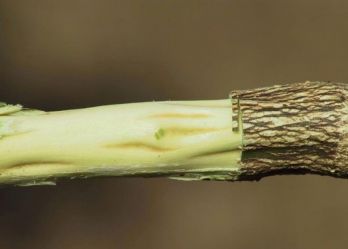Sweet orange stem-pitting
Sweet orange stem-pitting is caused by a variety of the destructive citrus tristeza virus (CTV).
Background
Strains of sweet orange stem-pitting are found only in Queensland where they are under official control. These can affect lime, grapefruit, and some rootstocks.
The mandarin stem-pitting strain of CTV is not present in Australia but has been reported in Indonesia, Japan, Malaysia, Taiwan and Thailand.
It is illegal to transport citrus budwood or trees from Queensland to other states, as outlined in Condition 3 of the Plant Quarantine Standard.
Impacts
CTV has many strains, ranging from mild with no visible symptoms on citrus plants, to severe damage. Trees with stem-pitting have:
- poor growth
- brittle branches
- reduced yield and fruit size.
Long-distance spread can occur by the movement of infected citrus planting material, such as budwood (but not seed). Aphids also spread CTV, and the most efficient vector is the brown citrus aphid (Toxoptera citricida), found in Australia.
The aphids require at least 30 to 60 minutes of feeding to acquire the virus, and they remain infectious for at least 24 hours after.
Management
Management
There are no cures for CTV. Growers can put on-farm biosecurity measures in place to reduce the chance of infection. These include:
- establishing new plantings with healthy propagating material from reputable nurseries or suppliers who:
- source their budwood from Auscitrus
- routinely test their seed and budwood for diseases, including CTV
- putting up farm biosecurity signs on gates and fences to manage visitors coming onto your property
- avoiding sharing equipment
- keeping equipment and vehicles clean and free of plant matter
- wearing clean clothing before visiting other growers’ properties
- teaching farm workers on-farm hygiene practices, what to look for, and how to report unusual pests and diseases
- reporting suspect symptoms to the Exotic Plant Pest Hotline.
Identification
Trees affected by sweet orange stem-pitting show an overall decline, including a reduction in fruit size and yield. Symptoms can occur on trunks, limbs of any size, and on twigs where fruit is produced.
Pits and grooves of different sizes in the wood often contain a yellow gum. Irregular growth of the phloem occurs in the area of these xylem pits.

